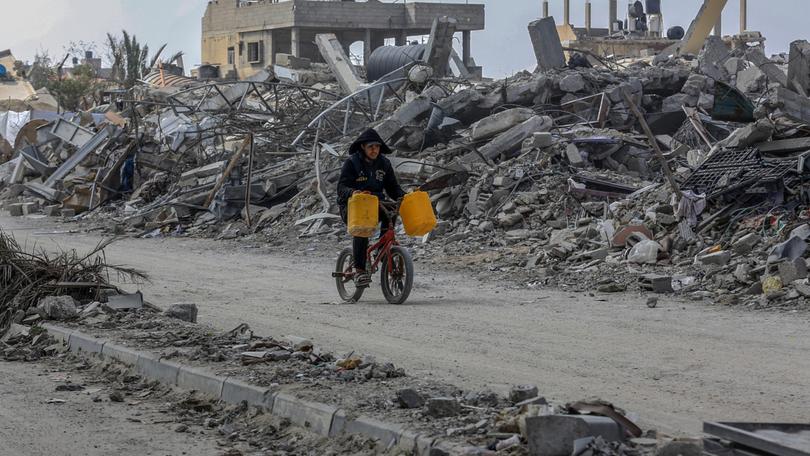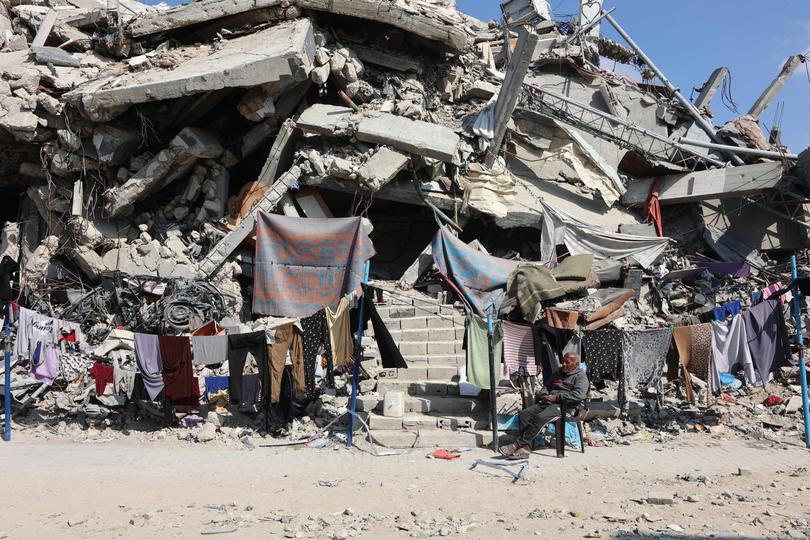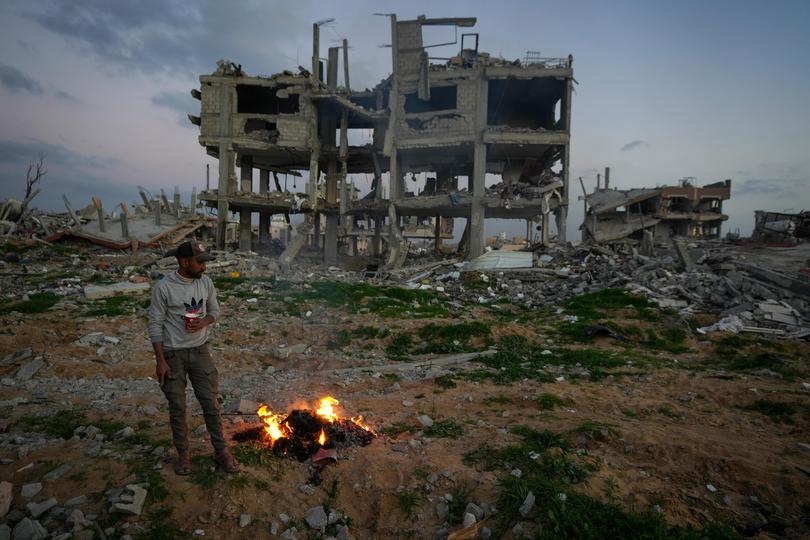THE WASHINGTON POST: What is making Gaza ‘uninhabitable?’ Unexploded bombs and more

Israel’s defence minister this week ordered the military to draft a plan for the “voluntary departure” of Palestinians from the Gaza Strip, saying he welcomed US President Donald Trump’s abrupt proposal to “take over” the enclave and displace all the people living there.
“I welcome President Trump’s bold plan, which could enable a large segment of Gaza’s population to relocate to various destinations around the world,” Defence Minister Israel Katz said.
The Israeli plan, he said, would allow Gaza residents to depart for “any country willing to receive them,” via land crossings or through “special arrangements for departure by sea and air”.
Sign up to The Nightly's newsletters.
Get the first look at the digital newspaper, curated daily stories and breaking headlines delivered to your inbox.
By continuing you agree to our Terms and Privacy Policy.Mr Trump’s announcement this week that the United States would “own” Gaza — a position he reiterated on Truth Social on Thursday, US time — drew swift condemnation from diplomats and world leaders, including Palestinian officials.
The United Nations warned that any forced displacement of Gaza’s two million people would be “tantamount to ethnic cleansing”.
Mr Trump has argued that the enclave, battered in Israel’s punishing war, is no longer fit for human life.
“This is just a demolition site,” he said this week, adding that “no one can live there.” His press secretary called Gaza “an uninhabitable place for human beings.”

About 90 percent of Gaza’s population was displaced during the war, crowding into a section of land along the coast under orders from the Israeli military. In the weeks since a ceasefire was reached between Israel and Hamas, hundreds of thousands of Palestinians have returned to their bombed-out homes, with many vowing to rebuild.
The scale of the damage is undeniably immense. After almost 16 months of conflict, the territory is in a state of historic ruin. Experts agree it will take decades to rebuild; the United Nations estimated last year that it would take 350 years for Gaza to return to pre-war levels of economic activity if Israel maintains its near-total blockade.
But while reconstruction efforts would probably be complicated by the numbers of displaced people still living in the ruins, international law generally prohibits the transfer of civilian populations, regardless of the motive. Palestinians also fear that they won’t be allowed to return.
“If you apply [Trump’s] logic historically, London would not have been rebuilt, Dresden would not have been rebuilt, Tokyo would not have been rebuilt,” Balakrishnan Rajagopal, UN special rapporteur on the right to adequate housing, said.
Unexploded weapons hinder rebuilding
Speaking on Tuesday, Mr Trump pointed to the unexploded bombs scattered across Gaza as a prime factor in his shock decision to assume control of the territory.
“We’ll own it and be responsible for dismantling all of the dangerous unexploded bombs and other weapons on the site, level the site and get rid of the destroyed buildings,” he said.
The United States provided Israel with some of the most destructive ordnance used in the enclave, including hundreds of 2000-pound MK84 bombs. Initially, Mr Trump said he would not rule out deploying US troops, something his press secretary was later forced to walk back.
“No soldiers by the U.S. would be needed!” Trump wrote on Truth Social on Thursday.
US private military contractors are now working in Gaza, inspecting vehicles at checkpoints along the Netzarim Corridor that divides the territory between north and south. But they are not engaged in explosives removal.
UN disposal teams have discovered hundreds of unexploded ordnance since the war began on October 7, 2023. These potentially deadly items include grenades, artillery shells and large aerial bombs — and their identification and disposal is a necessary first step before rubble can be cleared and the rebuilding can begin.
Experts have compared the aftermath of the Israeli bombing campaign in Gaza to Europe in the post-World War II period. There, the removal and disposal of dangerous armaments took years, sometimes decades, of intensive work.
“I’ve given up trying to work out how much ordnance [remains in Gaza], how long it’s going to take to clear it, and how much money it’s going to take,” Simon Elmont, an explosives expert for the nonprofit Humanity and Inclusion, said. He led some of the organisation’s work in Gaza last year and previously helped clear heavily bombed cities such as Mosul in Iraq.
The number of pieces of ordnance would be in the “tens of thousands”, Mr Elmont said. “My estimation is 25 to 30 years to get the priority [clearance] done.”

Luke Irving, a UN bomb disposal expert based in Gaza, told reporters on Thursday that officials have accounts of 24 victims from unexploded ordnance since the ceasefire started on January 19.
Only a handful of international disposal experts are operating in Gaza, but they say much of their work is hindered by a lack of equipment and staffing, caused in part by Israeli restrictions on what they can bring into the territory. They are prohibited from using explosives to destroy the ordnance; doing so is standard practice in most conflict zones.
They have also avoided working with local police, whose forces were targeted by Israel during the war. Some reports suggest police officers have carried out their own explosives removal. In some instances, international disposal experts have discovered unexploded ordnance, left the area and returned later to find the explosives removed.
“By who, we don’t know,” Mr Elmont said.
Destruction and supplies
UN estimates made via satellite imagery suggest that more than 60 percent of the buildings in Gaza have been destroyed or damaged since the start of the war. Critical infrastructure, including clinics, universities and water treatment plants, are in rubble.
The nonprofit Oxfam estimates that 1.6 million people are living in makeshift shelters. More than 47,000 people have been killed in the war, according to the Gaza Health Ministry, which does not distinguish between civilians and combatants but says the majority of the dead are women and children.
Under the ceasefire agreement, the number of trucks carrying fuel, food and other relief into Gaza has surged from an average of about 100 per day to as many as 900, according to UN figures.
But aid workers have said that key items such as construction vehicles for clearing debris, as well as tents for displaced people, remain stuck at the crossings because of Israel’s ban on what it considers dual-use items, or objects that could serve both military and civilian purposes.
“Ongoing harm to infrastructure and health care will mean greater morbidity and mortality for years to come,” Neta Crawford, co-director of the Costs of War Project at Brown University, which tracks the toll of conflicts, said. “This is the indirect harm of war that can kill more people than die from bombs, bullets and fire.”
Uncertain costs, future
The United Nations estimates that rebuilding Gaza to its prewar state could cost $US80 billion ($127.3b), and it is unclear which countries will foot the bill.
Despite Mr Trump’s remarks, White House press secretary Karoline Leavitt said on Wednesday that the administration does not intend to pay for reconstruction in Gaza. Wealthy Arab monarchies have expressed an openness to funding rebuilding efforts but want reassurances that a Palestinian governing body would lead the Strip.
“There is a long tradition of those who destroy a place paying for its reconstruction,” Ms Crawford said, noting that the United States had paid tens of billions of dollars in reconstruction costs in Iraq and Afghanistan.
Mr Rajagopal, the UN special rapporteur on the right to adequate housing, said that in some ways, the situation in Gaza is similar to that in Tokyo in 1945, where well over one million people were left homeless after Allied firebombing attacks at the end of World War II.
But the rebuilding there was completed in less than a decade and did not include the mass displacement of the city’s population.
There were two main factors, Mr Rajagopal added. First, the war had clearly ended for good. And second, “the American occupation in Tokyo actually had the policy of assisting the local population to return and to rebuild”.
“They contributed an enormous amount of resources to it,” he said.
© 2025 , The Washington Post
